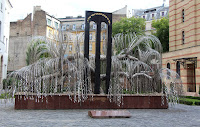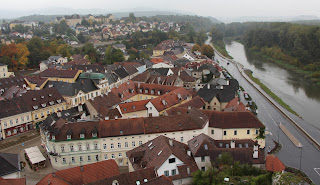 |
| This experience leaves Starbucks in the dust |
Budapest is full of surprises. Imposing buildings in all sorts of
architectural styles line both sides of the Danube. Linked together by a series of bridges, the hills of Buda and the flatlands of Pest
form the city that is Hungary’s capital.
Cosmopolitan, sophisticated yet a little faded in parts, the city has
many faces. Emerging from a long history of occupation and repression, after
the fall of the Iron Curtain in 1989 a Hungarian renaissance has emerged.
We met our local guide Orsi to begin our discovery of the city, walking
the nooks and crannies of Pest. She introduced us to Budapest's coffee culture which dates back over 150 years. Some of the
coffee houses look as though they have been frozen in time, high ceilings,
magnificent fixtures, mirrors and glass and of course the coffee and exquisite
cakes. The Gerbeaud Café and
Confectionary in Vorosmarty Square likely the grand dame of them all.
 |
Chimney Cake
Finally a pronounceable name ! |
This was just the beginning of our morning with Orsi. A culinary tour like no other. A tasting of artisan cheese, chutneys,
mustards, jams and fruit brandy produced organically and sold at Balaton
Izlelo. Cardamom, tarragon and lavender flavoured chocolates from Green
Hat - and then a revelation.
The Trdelnik we had enjoyed in Prague apparently originates from
Transylvania and is a Hungarian speciality called Kurtoskalacs or
Chimney Cake. A baker gave us a personal demonstration. Made from sweet dough spun around a
cone-shaped baking spit and rolled in granulated sugar the dough is baked above
charcoal cinders until it is golden brown. The sugar turns into caramel and
toppings of ground walnut and cinnamon are added.
 |
| Budapest's Central Market |
Our next stop was the lively Central Market Hall with three floors to
discover. The sampling continued with
pungent cheeses, salami of all kinds - particularly good the Mangalica -
pork from the Hungarian woolly pig.
 |
| A mecca for foodies |
All
manner of pickles, cabbage strudl, and what can only be described as pork
scratchings. Our cholestrol count rising
rapidly it was probably fortunate the line up for the Langos, deep fried
flat bread with sour cream, garlic and cheese, was a little too long. We left the frenetic atmosphere of the Market
for our official lunch stop.
 |
| Enough to feed an army. Quite possibly one sausage too far. |
A tram ride later we arrived at Belvarosi Disznotoros, a
butcher-caterer specializing in sausages, schnitlzl, duck, rabbit and pork. Not
particularly hungry, we tried to do the generous plate of sausages, red cabbage
and potatoes justice, as we stood to eat at the outdoor tables, rubbing shoulders
with the locals. A little went a long
way and we needed to walk off our indulgences.
A brisk walk to the Seventh District, once the heart of the Jewish
community, we admired the exterior of the world’s second largest Synagogue, an
eclectic mix of Romantic and Moorish architecture.
 |
| The Emanual Tree |
It’s difficult not to be moved by the Raul Wallenberg Memorial Park located
alongside the Synagogue walls. A
sculpted weeping willow tree bears the names of Jewish victims of the Nazi
occupation, each name inscribed on one of the metal willow leaves. Interestingly the memorial was sponsored by
the Emanual Foundation of New York created in 1987 by Tony Curtis in
honour of his father, Emanuel Schwartz.
 |
St. Stephen's Basilica
City view from the Wheel |
Budapest’s neoclassical cathedral, St. Stephen’s Basilica was our final
cultural stop of the day. A little gloomy inside but nevertheless impressive, a
large wedding was in progress with a choir and orchestra in attendance,
creating a dramatic sense of occasion.
 |
| Some mighty fine reds at DaVino |
Orsi’s final culinary blow of the day was the DaVino Wine Bar across
from the Basilica. The array of
Hungarian wines impressive, we enjoyed a tasting of fine reds while Orsi went
home to celebrate her mother’s birthday.
We would reconvene in the morning.
Across the square a more modern attraction awaited - Felnott Jegy, a
ferris wheel. While it seemed a little
out of place, the views from the top of the wheel were worth the ride.
 |
| The Parliament Building |
 |
| The Chain Bridge |
After a change of footwear to salve our aching feet, we ventured down to
the Danube so that we could cross the iconic Chain Bridge and view the
Parliament Buildings.
Both are icons of
the Budapest skyline and as daylight gave way to twilight we appreciated the
reflections in the Danube emanating from the illuminated buildings. Walking
back to the hotel we knew there would be no need for dinner this evening, Orsi
had seen to that!






















































